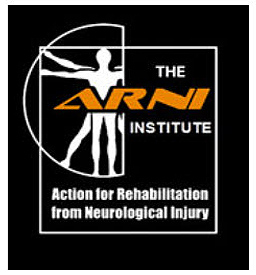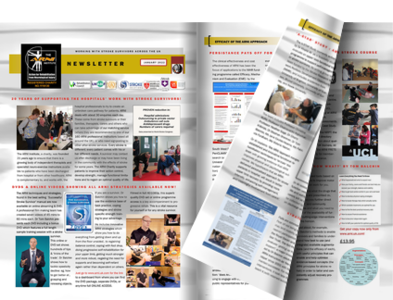is training with Felicia Sheingold: he is progressing brilliantly, and has moved in a couple of months from standing for a few minutes by himself, to walking unaided and moving onto a weights programme! Go Simon!!
News
Contact ARNI for Home Based Rehab with a Qualified Instructor
We are on Facebook
This research indicates that acute exercise therapies, especially aerobic exercise and resistance training, can markedly enhance the motor function, cardiovascular health, neuroplasticity, and functional recovery in stroke survivors. Enhancements in strength, gait, balance, and endurance were frequently noted, accompanied by moderate impacts on quality of life and functional autonomy. Brain imaging outcomes related to neuroplasticity indicate that acute exercise can facilitate brain reconfiguration and enhance recovery. In general, acute exercise was determined to be safe and practicable, with few adverse outcomes.
Read more in the full article:
www.academia.edu/2994-435X/2/2/10.20935/AcadMed7769?article_card=download&source=academia-medicin...
www.arni.uk.com
#neuroplasticity #strokeexercise #strokesurvivorscan #strokerecovery #neurorehab #strokerehab #exerciseafterstroke #strokerecoveryexercises #neurorehabilitation
... See MoreSee Less

ARNI STROKE CHARITY NEEDS YOUR HELP! PLEASE DONATE JUST A FEW £ NOW TO HELP US ASSIST SURVIVORS - THANK YOU SO MUCH 😇! - ... See MoreSee Less
Here's a tip if you're faced with stairs that have no handrail/handrail on the wrong side.
Get the person with you to stand one step lower and put your hand on their shoulder for support while you take a step.
If you like this post then please share it with others. Each time that you share a post, you can directly help other people – as who knows which people in the world might find us and gain, either directly from the charity or simply by being able to copy an ‘innovative and useful’ move/trick of the trade that might help them manage after stroke.
Every time you share, you could directly help someone – as knowledge is power ;)
www.arni.uk.com
#neuroplasticity #strokerehabilitation #strokerecovery #arnistrokerehab #neurorehab #ARNIstrokerehab #stairsafterstroke
... See MoreSee Less

My nightmare
Did you know that incorporating higher-intensity walking into early stroke rehabilitation significantly improves patient outcomes, including mobility and quality of life? Here's a more detailed explanation:
Higher Intensity, Better Outcomes:
Research suggests that higher-intensity exercise, including walking, during the initial phase of stroke rehabilitation leads to better recovery outcomes.
"Walk 'n Watch" Protocol:
A specific protocol called "Walk 'n Watch" has been developed to increase the intensity of walking exercises in stroke rehabilitation.
Real-World Implementation:
This protocol has been successfully implemented in real-world rehabilitation settings, demonstrating its feasibility and effectiveness in improving patient mobility and quality of life.
Improved Mobility and Quality of Life:
Patients who participate in this higher-intensity walking program show improvements in walking distance, speed, and overall quality of life.
Increased Step Count:
A study found that stroke patients in inpatient rehabilitation following the implementation of high-intensity stepping training took significantly more steps per day compared to those receiving usual care.
Clinical Significance:
These improvements are not only statistically significant but also clinically meaningful, indicating a tangible difference in patients' ability to walk and perform daily activities.
www.arni.uk.com #strokerehabilitation #neurorehab #neuroplasticity #strokesurvivorscan #strokerecovery #strokeexercise #neurorehabilitation #strokerecoveryexercises #exerciseafterstroke
... See MoreSee Less

To initiate Neuroplasticity in the injured brain, more repetition and task specific practice is needed. The best stroke rehabilitation therapies exploit how neuroplasticity works by using repetitive positive experiences to forge and strengthen pathways in the brain. The more the survivor repeats and practices an activity, the stronger new pathways in his brain become.
You can make the most of the recovery by continuously using the affected parts of the body in everyday life. It’s also important to keep using a skill after re-learning it.
If you need some help then call us on 0203 053 0111 or email support@arni.uk.com We have trainers throughout the country who can help you with your recovery.
www.arni.uk.com
#strokerehabilitation #arnistrokecharity #neuroplasticity #ARNIstrokerehab #strokerecovery #strokeexercise #arnistroke #neurorehab #arnistrokerehab
... See MoreSee Less

I have written the following review which you are free to post:
I suffered an Ischaemic stroke earlier this year shortly after my 45th birthday that resulted in total right-sided paralysis. After a lengthy stay in hospital where the fantastic staff started me on this long process of rehabilitation I am now back home with my family.
I was exploring many different avenues to assist with my recovery alongside the physio and therapy sessions provided by the local NHS community team and was recommended looking at the materials provided by the Arni Institute and in particular the set of DVDs delivered by Dr. Tom Balchin.
It was reassuring to identify with so many of the challenges that myself and many other stroke survivors face. As Tom has been on a similar journey he is able to talk with first-hand experience through many issues with clarity, expertise and compassion.
I find myself rewatching the DVDS whilst completing my daily exercises and find they help motivate me to improve further.
Thank you to Dr Tom and all at the Arni Institute/Stroke Solutions for the great work you do.
www.arni.uk.com
#strokerecovery #strokesurvivorscan #strokeexercise #neuroplasticity #strokerehabilitation #neurorehab #exerciseafterstroke #strokerehab #neurorehabilitation #strokerecoveryexercises
... See MoreSee Less

The worth of any approach to stroke recovery comes down to three things:
1. How well it can be understood?
2. Does it work for you?
3. How well can you incorporate it into your daily life?
www.arni.uk.com
#strokerecovery #strokeexercise #neurorehab #strokerehabilitation #neuroplasticity #exerciseafterstroke #strokerecoveryexercises #exercisestroke
... See MoreSee Less

The human brain is powerful, but what happens when it faces life-altering trauma? This webinar is worth taking the time to watch. It's Dr. Jill Bolte Taylor, a Harvard-trained neuroanatomist, who suffered a severe stroke that left her unable to walk, talk, or recall her lif#neurorehabilitationa#exerciseafterstroket#neurorehabr#strokerecoveryo#strokerehabilitationa#strokeexerciser#strokesurvivorscanr#neuroplasticityi#strokerecoveryexercisescises ... See MoreSee Less

It's good to have the brain on your side as mine once was. Recent years it seems to be opposing me Why else would my promising recovery stop and go into reverse
The Successful Stroke Survivor Full Video Series: 300 minutes anytime online viewing
You are about to completely change the way you view your rehabilitation. By following the advice in these 7 DVDs you will totally transform yourself. You will be able to disregard the use of a wheelchair, stick and rigid plastic orthotic, as appropriate. Amongst many other things, you will learn to get down and up from the floor, balance, walk and turn without problem, become strong and robust.. and tackle all sorts of activities of daily life that you hadn’t dreamed possible after stroke.
Importantly, Dr Tom will teach you how to recover a great deal more action control of your upper limb and achieve spasticity decline leading to grasp and release capability. Contained in these DVDs is a wealth of information relayed by Dr Tom, who has ‘been there’. A stroke survivor himself, he shows you exactly what to do to make an incredible recovery: you will not BELIEVE what can be done! You can do it: Dr Tom will show you how, and will also show you a full training session with a stroke survivor so you can see how everything works.
#strokerehabilitation #strokerehab #neuroplasticity #neurorehab #strokerecovery #strokeexercise #exerciseafterstroke #strokerecoveryexercises #strokesurvivorscan #neurorehabilitation
... See MoreSee Less

www.strokesolutions.co.uk
You are about to completely change the way you view your rehabilitation. By following the advice in these 7 DVDs you will totally transform yourself. You will be able to disregard the use of a wheelch...
On bad days, remind yourself, I AM A SURVIVOR. If anyone calls you a stroke victim, immediately correct them and proudly announce, “I am a stroke survivor.” You have worked hard for this. You’ve pushed yourself for this. You’ve overcome obstacles for this. You’ve earned this.
The difference between calling yourself a stroke victim and a stroke survivor is an extremely important mindset shift for your recovery. Words are very powerful, and they shape how we view ourselves and the world. In the case of those who have experienced a stroke, words can give you the strength to propel yourself forward to be the best you can be after a stroke, versus merely subsisting at your current level of recovery.
www.arni.uk.com
#ARNIstroke #strokerecovery #ARNIstrokerehab #arnistrokecharity #neurorehab #strokerehabilitation #strokesurvivors #strokeexercise #neuroplasticity #arnistroke #arnistrokerehab
... See MoreSee Less

Very true 👍 it's about positive attitude

